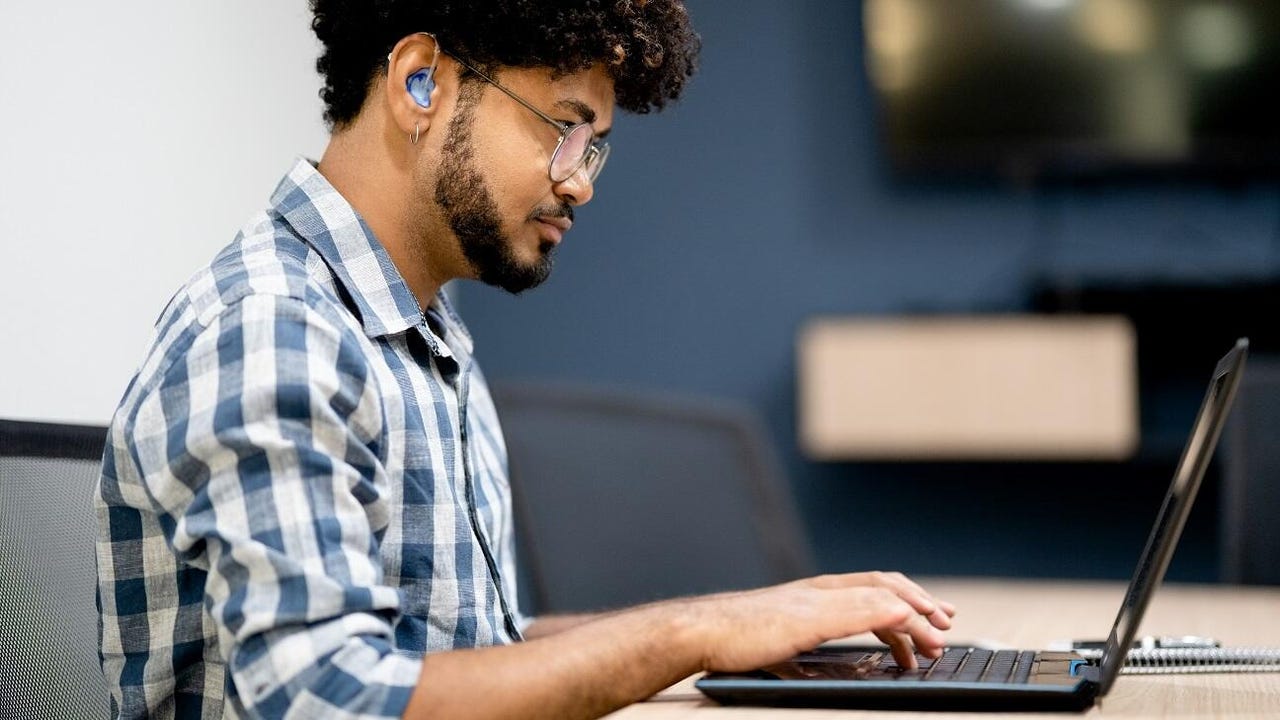'ZDNET Recommends': What exactly does it mean?
ZDNET's recommendations are based on many hours of testing, research, and comparison shopping. We gather data from the best available sources, including vendor and retailer listings as well as other relevant and independent reviews sites. And we pore over customer reviews to find out what matters to real people who already own and use the products and services we’re assessing.
When you click through from our site to a retailer and buy a product or service, we may earn affiliate commissions. This helps support our work, but does not affect what we cover or how, and it does not affect the price you pay. Neither ZDNET nor the author are compensated for these independent reviews. Indeed, we follow strict guidelines that ensure our editorial content is never influenced by advertisers.
ZDNET's editorial team writes on behalf of you, our reader. Our goal is to deliver the most accurate information and the most knowledgeable advice possible in order to help you make smarter buying decisions on tech gear and a wide array of products and services. Our editors thoroughly review and fact-check every article to ensure that our content meets the highest standards. If we have made an error or published misleading information, we will correct or clarify the article. If you see inaccuracies in our content, please report the mistake via this form.
How can you honor Disability Independence Day? Start by improving your website's accessibility.


Independence Day is the quintessential American holiday. Every July 4, parties, parades, speeches, food, and fireworks commemorate the day that the country declared independence from British colonial rule.
There's another important day in July that you may not know about. On July 26, 1990, former President George H.W. Bush signed the Americans with Disabilities Act. The law aims to ensure people with disabilities have equitable opportunities, rights, and access.
Ever since, July 26 has been celebrated as National Disability Independence Day.
The law is often called the ADA for short. The ADA prohibits discrimination against people with disabilities in education, employment, transportation, public accommodations, communications, and access to government programs and services. A lack of access — or inequitable access — could be considered discrimination.
The Rehabilitation Act of 1973 laid the foundations for the 1990 ADA. That law required federally funded programs to be accessible to people with disabilities. In addition, Section 504 of the 1973 law prohibited discrimination based on disability by programs that receive federal money.
How many people are affected by a disability?
Twenty-six percent of Americans have some type of disability, according to the U.S. Centers for Disease Control.
According to the CDC, nearly 14% of American adults have a mobility-related disability that may make walking or climbing stairs difficult or impossible. Nearly 6% of adults have a hearing-related disability, and nearly 5% have a vision-related disability.
Almost 11% of adults have a disability that affects their ability to concentrate, remember information, or make decisions. Around 7% have difficulty doing errands on their own, and almost 4% of adults with a disability have difficulty with self-care tasks, like bathing and getting dressed.
Many people also have more than one type of disability.
The World Health Organization defines disability as "any condition of the body or mind (impairment) that makes it more difficult for the person with the condition to do certain activities (activity limitation) and interact with the world around them (participation restrictions).
According to the United Nations, 1 billion people — 15% of the world's population — have some type of disability.
How can you improve your website's accessibility?
The adoption of new technologies can help increase access for people with disabilities.
Digital accessibility is just one issue that challenges some people with disabilities. Georgetown University's law school defines digital accessibility as
The inclusive practice of removing barriers that prevent interaction with, or access to websites, digital tools, and technologies, by people with disabilities.
For example, screen readers, text-to-speech, and voice recognition can help people communicate independently. Closed captions allow people with a hearing impairment to watch online videos, streaming service shows, or movies.
Artificial intelligence powers apps like Companion, which can allow people to live with more independence. Timer apps on smart devices, for instance, are helpful for people who may have a cognitive impairment and struggle with time management in the classroom or at work.
And using technology to improve or redesign existing devices may allow people with mobility challenges to move through their day with greater independence. Devices can assist with tasks like getting dressed or going inside a store to complete an errand.
Accessible web technology is inclusive because it allows people with disabilities to live more connected and independent lives. Here are three ways you can improve your website accessibility.
1. Include alt text
Can you imagine scrolling through your social media feed or a webpage with no images?
When alt text is missing, that's what the experience might be like for people with a vision impairment.
Instead of enjoying the latest funny meme, photos of family and friends, or an interesting image that accompanies a news story, they might encounter nothing but generic descriptions, like "man on bicycle at the beach," or "woman sitting behind a desk" — or even worse, a meaningless file name like Image-01.
Using alt text can prevent this from happening for the millions of people who use screen readers. Screen reading software and apps use alt text to describe images aloud. They can provide context and voice to web pages.
As with most creative tasks, learning to write good alt text is a blend of art and science. Check out this guide as a starting point for what you need to know about writing effective alt text.
Bonus: Creating a webpage that makes good use of alt text also can also improve your position in search engine results pages. One reason? Alt text can also double as keywords which, in turn, can increase your page's visibility and performance in SERPs.
2. Incorporate universal design
When designing or redesigning your website or any digital content, think about people who:
- May have a hearing impairment
- May struggle to read too-small or low-contrast text
- May try to access the site on a shaky wi-fi connection on a small screen in a public setting like a library or coffee shop
Ireland's National Disability Authority defines universal design as
The design and composition of an environment so that it can be accessed, understood and used to the greatest extent possible by all people regardless of their age, size, ability or disability.
Universal design elements include equity, flexibility, and simplicity in use, along with tolerance for error.
As with alt text, an additional benefit of incorporating universal design principles is that the website will be easier to read and use for everyone, whether they have a disability or not. Inclusive design elements for a website might include:
- Choose simple fonts — sans serif, 12 or 14 point in easy-to-read contrasting colors.
- Break up long passages of text with headings.
- Keep navigation consistent from page to page.
- Ensure the site can be navigated by keyboard.
- Turn off videos that autoplay. Allow people to decide if and when they want to watch.
- Include captions or transcripts for videos.
- Give links descriptive, unique names.
- Optimize for mobile. On ZDNet.com, for example, 45.6% of global website visits in the last 12 months came from mobile devices. In the US, 49.2% of our website visits were on mobile.
3. Write clearly and concisely
Using simple, direct language can improve any website.
Avoid buzzwords or jargon. If you must use complex words or phrases — to meet legal requirements, for example — consider supplementing the text with illustrations or a glossary.
If you don't have strong writing skills, free tools like Grammarly and Hemingway can help.
If all these suggestions seem overwhelming, don't worry. Organizations like the Web Accessibility Initiative have comprehensive and free resources available. They include Web Content Accessibility Guidelines, published by the World Wide Web Consortium.
What are employment opportunities like in tech for people with disabilities?
It's difficult to precisely quantify how many people with a disability work in tech. But overall, about 19% of all Americans with a disability were employed in 2021, according to the U.S. Bureau of Labor Statistics. That's up from 17.9% in 2020.
In contrast, 64% of people without a disability were employed in 2021.
The unemployment rate for people with disabilities decreased by 2.5 percentage points from the previous year (BLS). However, the jobless rate for people with a disability was about twice the rate for people without a disability.
Sometimes just getting hired for a tech job is the first challenge. Even though the ADA prohibits workplace and hiring discrimination based on disability, this discrimination still occurs.
But once hired, the tech sector's culture can be a difficult environment for people with disabilities. For example, many companies expect employees to work long hours or on nights and weekends with no notice.
While problematic for anyone, working long hours or after hours with no notice can be untenable for someone with a disability. However, pandemic-driven shifts in work-life balance may have improved this situation.
Resources
If you want to connect with or hire people with disabilities in tech, check out these resources:
Chronically Capable connects people with chronic illnesses to employers that want professionals with digital skills.
Illimitable describes itself as an organization that celebrates diversity, prioritizes accessibility, and emphasizes that accessibility is a human right.
Open Sourcing Mental Health is a nonprofit that focuses on raising awareness and providing resources that support mental health in the tech and open source communities.
Key takeaways
If you're struggling with where to start, here are three simple things you can do to be inclusive of people with disabilities and honor the spirit of Disability Independence Day throughout the year:
Respect individual experiences
Remember that people may experience the same disability in different ways. For example, two people with a similar physical disability may want or choose different types of accommodation or assistance.
Recognize a person's full identity
Never reduce a person to their disability. But, on the other hand, totally ignoring someone's disability isn't helpful or realistic either. A writer on paraquad.org put it like this: "While my disability is not who I am, it helped shape me into the person I am today."
Be present and humble
As with all attempts at allyship, people can mean well but still get it wrong. Try to balance good intentions, action, and humility. As founder and CEO of accessibility resource Access Now Maayan Ziv puts it, "It is better to be an imperfect ally than nothing at all."
This article was reviewed by Laila Abdalla, Ph.D.
Laila Abdalla obtained her Ph.D. in English from McGill University in Montreal, Canada. She taught undergraduate and graduate courses in English and successful writing at Central Washington University for over 21 years.
Currently, Abdalla serves as a Washington state career coach and advocate for individuals on temporary state assistance. Abdalla has devoted her career, teaching, and leadership to matters of equity, diversity, and inclusion. Above all, she is committed to her clients' and students' complete experience, raising awareness of BIPOC issues in employment, language, community, and culture.
Abdalla leads with equity in management and nonprofit volunteering and continues to develop her own understanding of these complex issues — both professionally and in her lived experiences.
Laila Abdalla is a paid member of the Red Ventures Education Integrity Network.
Last reviewed June 15, 2022.